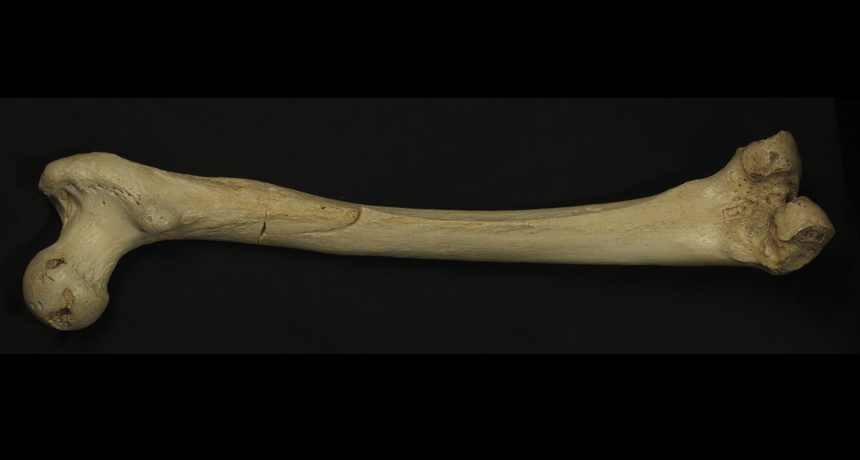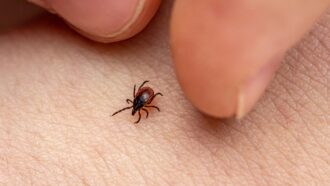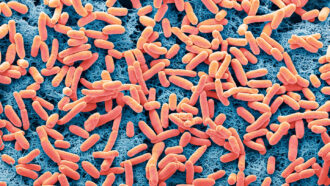Ancient DNA sparks new mystery
DNA from a bone found in Spain is the oldest yet recovered from a pre-human relative and suggests a surprising link between two types of humanlike ancestors

This 400,000-year-old leg bone contained the oldest known DNA to come from pre-human ancestors. The bone was found in the Sima de los Huesos, or “pit of bones,” in Spain. Surprisingly, scientists have linked the bone to a much more recent human ancestor whose fossils have been found only in East Asia.
Javier Trueba, MADRID SCIENTIFIC FILMS
DNA from a 400,000-year-old leg bone is breaking records. It also raises questions about how closely ancient humanlike creatures were related to each other. The genetic material is four times older than any other recovered from a pre-human ancestor, or hominid. And scientists say the DNA links this individual, recovered from Spain, with a much later humanlike group called Denisovans. Their remains have been found only in East Asia’s Siberia.
The newly studied leg bone turned up nearly a decade ago. Scientists retrieved it from among the fossil remains of at least 28 individuals. All were found in a cave in Spain known as the “pit of bones.” All belonged to a humanlike species that resembled people but existed long before them.
A species is a group of living things that can produce offspring that can survive and reproduce. All species — from people to boa constrictors to red maples — evolve. That means they change slowly over long periods of time. This change, or adaptation, usually occurs in response to natural variations in DNA. A long and spiral-shaped molecule, DNA is found inside almost every cell of the body. It holds the operating instructions that tell a cell what to do. Each parent passes along half of his or her DNA to any offspring. So when DNA morphs, as it often does, offspring can inherit these altered cellular instructions.
Matthias Meyer studies the DNA instructions, or genes, of ancient species at the Max Planck Institute in Leipzig, Germany. His team’s new discoveries from the ancient leg bone were published Dec. 4 in Nature.
Most scientists consider bones from the Spanish pit to be the remains of a species known as Homo heidelbergensis. This hominid may be an ancestor of Neandertals, an ancient species that roamed Europe. What stunned the scientists was the leg bone’s genetic links to Denisovans.
A finger bone and two teeth found in Siberia — far from Spain — are the only known evidence of Denisovans. And those fossils indicate Denisovans lived more than 350,000 years after the leg bone’s owner.
Two types of DNA carry the genetic material in each individual. The form found inside a cell’s nucleus contains genes inherited from both parents. A second type of DNA possesses material passed along only from a child’s mother. It’s found outside the nucleus, in mitochondria (MI toh KON dree ah). These are segments of a cell where energy is produced. Meyer’s team focused on this mitochondrial DNA.
John Hawks at the University of Wisconsin-Madison studies ancient humanlike species. The new DNA study makes a surprising connection between ancient humanlike groups, he told Science News. However, he said, it also raises important questions about where and how those hominids might have come together.
Concludes Hawks: “The Denisovan connection is fascinating, but I’m cautious about how to interpret it.”
Power Words
Denisovans An ancient humanlike population whose existence is known only because of a few fossils discovered in a cave in Siberia.
DNA (short for deoxyribonucleic acid) A long, spiral-shaped molecule inside most living cells that carries genetic instructions. In all living things, from plants and animals to microbes, these instructions tell cells which molecules to make.
evolve To change gradually over generations, or a long period of time. In living organisms, the evolution usually involves random changes to genes that will then be passed along to an individual’s offspring. These can lead to new traits, such as altered coloration, new susceptibility to disease or protection from it, or different shaped features (such as legs, antennae, toes or internal organs).
gene A segment of DNA that codes, or holds instructions, for producing a protein. Offspring inherit genes from their parents. Genes influence how an organism looks and behaves.
genetic Having to do with chromosomes, DNA and the genes contained within DNA. The field of science dealing with these biological instructions is known as genetics.
mitochondria (sing. mitochondrian) A structure in all cells (except bacteria) found outside of their nuclei. Here the cell breaks down nutrients and converts them into a form of energy known as ATP.
nucleus (in biology) A dense structure present in many cells. Typically a single rounded structure encased within a membrane, the nucleus contains genetic information.
Neandertal A species (Homo neanderthalensis) that lived in Europe and parts of Asia from about 200,000 years ago to roughly 28,000 years ago.
species A group of similar organisms capable of producing offspring that can survive and reproduce.







